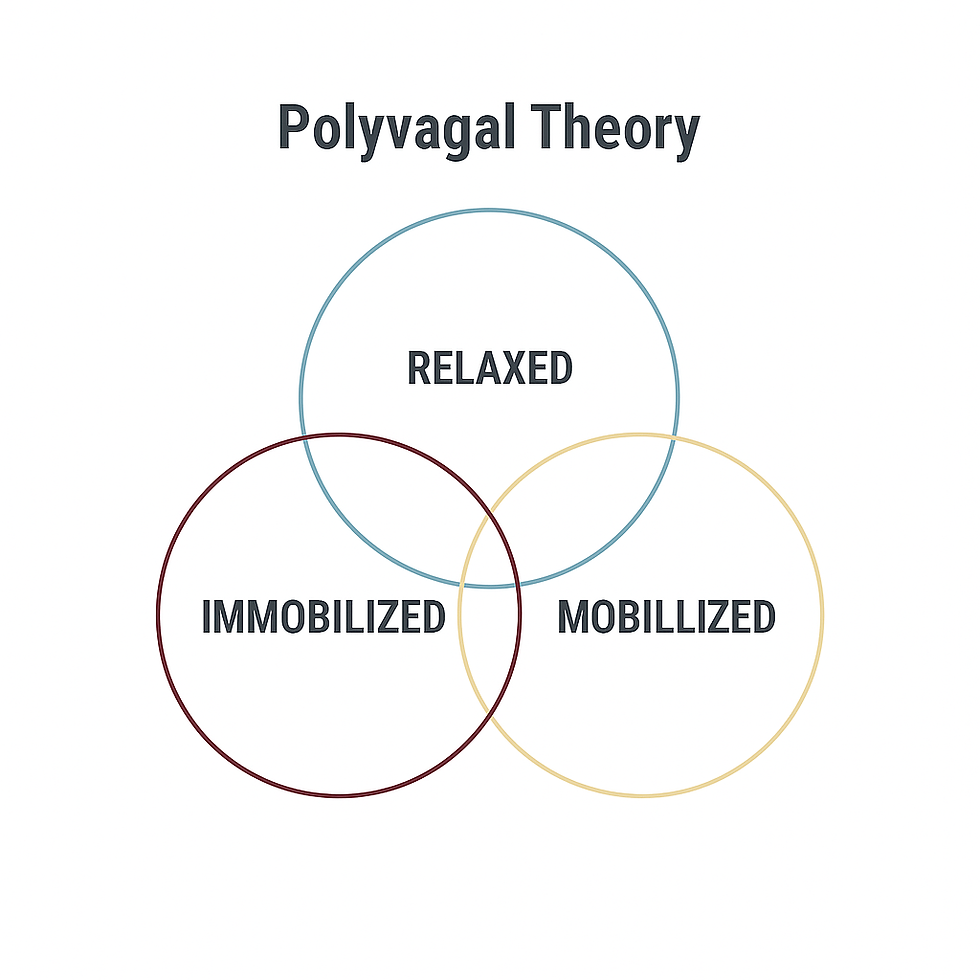Understanding Trauma Through the Lens of Polyvagal Theory
- Jaz Forrester
- Nov 19, 2024
- 3 min read
Updated: Jun 16
Trauma affects how we perceive and respond to the world, often leaving us stuck in patterns of survival that feel beyond our control. To better understand these responses, the Polyvagal Theory, developed by Dr. Stephen Porges, provides a powerful framework. It explains how our nervous system reacts to stress and trauma and how we can work toward healing.

The Polyvagal Theory: A Nervous System Map
At its core, the Polyvagal Theory focuses on the vagus nerve, a key player in our autonomic nervous system. This system operates largely without conscious thought, managing essential functions like heart rate, digestion, and emotional regulation. According to the theory, our nervous system operates within three distinct states, each influencing how we engage with the world:
Ventral Vagal State – Safety and Connection
When we feel safe and secure, our ventral vagal system is active.
This state supports social engagement, calmness, and clear thinking.
Trauma can reduce our ability to access this state, leaving us feeling disconnected or anxious.
Sympathetic State – Fight or Flight
In the face of danger, our sympathetic system activates.
This state prepares us to fight or flee by increasing heart rate, releasing adrenaline, and heightening alertness.
For those with trauma histories, this state can become overactive, leading to chronic anxiety or restlessness.
Dorsal Vagal State – Shutdown and Disconnection
When threats feel overwhelming, the dorsal vagal system may take over.
This state is characterized by feelings of numbness, fatigue, and disconnection.
While this response is protective, prolonged activation can lead to feelings of helplessness and depression.
Trauma and the Nervous System
Trauma disrupts our ability to shift smoothly between these states. Instead of experiencing a flexible flow, trauma can leave us stuck in survival responses, even when the danger has passed. For example, someone who experienced chronic stress in childhood might find themselves constantly in "fight or flight," feeling on edge and ready to defend themselves. Alternatively, another person might default to "shutdown," withdrawing from the world as a way to cope.
Healing Through Understanding and Regulation
The good news is that our nervous system is adaptable. By understanding how trauma affects our state, we can begin to work toward healing. Here are a few ways to support nervous system regulation:
Awareness: Learn to recognize your current state. Are you feeling calm, agitated, or withdrawn? Naming your experience is the first step toward shifting it.
Co-Regulation: Safe connections with others can help soothe your nervous system. A supportive therapist or loved one can provide a sense of safety when it feels hard to find on your own.
Self-Regulation Practices: Techniques like deep breathing, grounding exercises, or gentle movement can help activate the ventral vagal system and promote a sense of safety.
Therapeutic Support: Trauma-informed therapies, such as EMDR or somatic approaches, can address the root causes of dysregulation and create new patterns of resilience.
Moving Forward
Healing from trauma takes time and patience. Understanding Polyvagal Theory offers a compassionate lens to view your experiences, helping you make sense of your feelings and responses. With the right tools and support, it’s possible to reconnect with a sense of safety and regain the capacity to thrive.
At Core Trauma Therapy, we specialize in trauma-informed care and are here to support you on your healing journey. If you'd like to explore how this understanding can help you, please reach out to discuss your needs.
more information found at https://www.polyvagalinstitute.org/whatispolyvagaltheory

